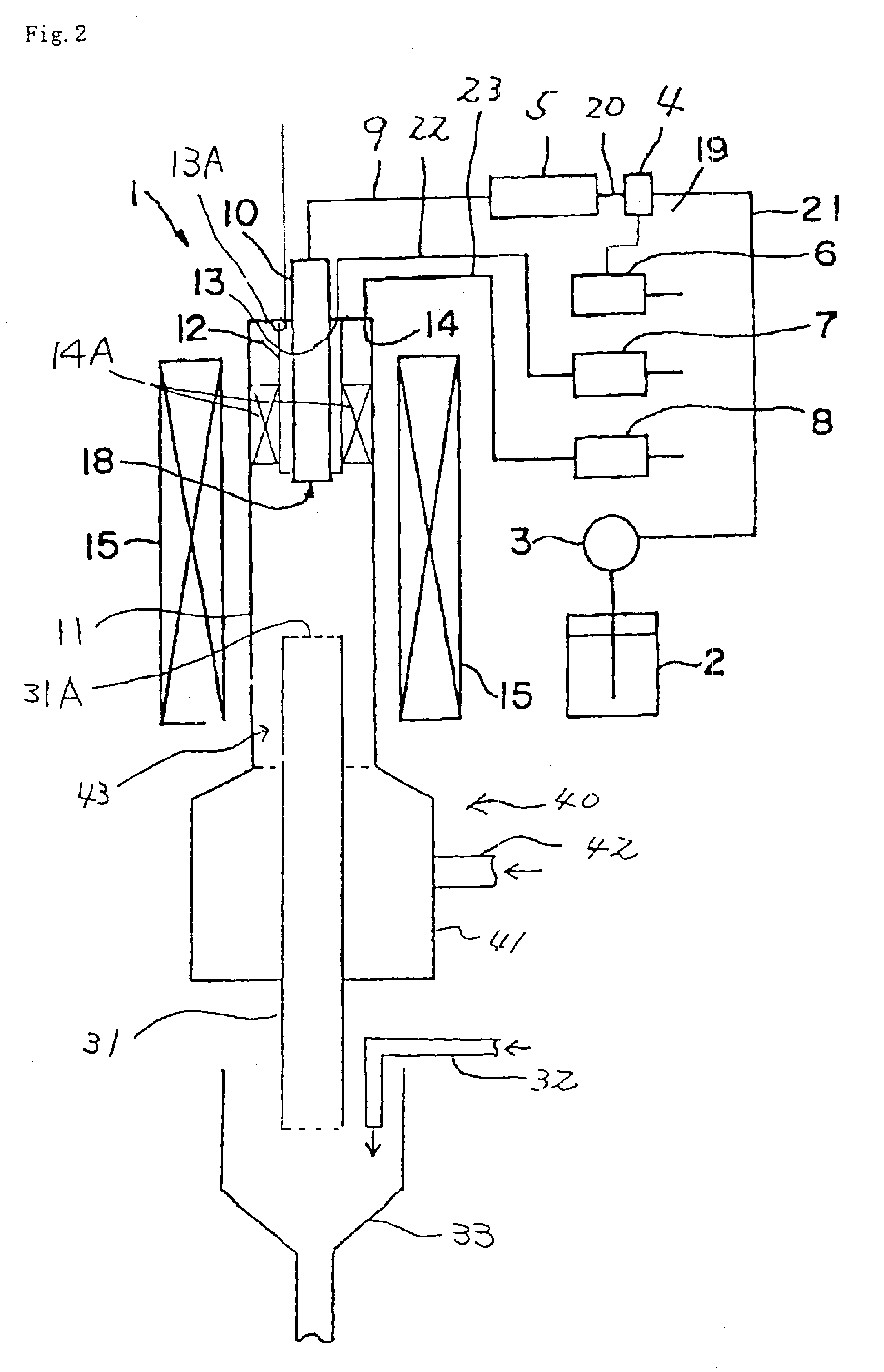Carbon fibrous matter, production device of carbon fibrous matter, production method of carbon fibrous matter and deposit prevention device for carbon fibrous matter
a technology of carbon fibrous matter and production device, which is applied in the direction of carbonsing rags, combustion types, lighting and heating apparatuses, etc., can solve the problems of inconvenient industrial operation, fibrous products, and inferior physical properties of carbon
- Summary
- Abstract
- Description
- Claims
- Application Information
AI Technical Summary
Benefits of technology
Problems solved by technology
Method used
Image
Examples
example 1
Carbon nanofibers were produced with the apparatus for production of carbon fibrous materials, as shown in FIG. 2, under the following conditions.
(1) Vertical Furnace of tubular reactor 11: Pipe made of silicon carbide
Inner diameter; 9 cm; outer diameter: 10 cm; length: 200 cm;
Distance from the feedstock-supplying nozzle to the bottom opening: 100 cm;
Temperature distribution within the reactor:: Temperature of the uniform-temperature zone (uniformly heated zone) from the feedstock-supplying nozzle down to the position distant by 80 cm from the nozzle: 1120-1100° C.; and temperature of the temperature-reduced zone further down to the position distant by 20 cm from the uniformly heated zone: 1100-900° C.;
Composition of feedstock gas: 0.12 mol % of ferrocene, 0.10 mol % of thiophene, 5.80 mol % of toluene, 93.98 mol % of hydrogen;
Flow rate of the gas supplied from the feedstock-supplying nozzle: 2.60 liters / min.;
Flow rate of the carrier gas (hydrogen) supplied from the cooling gas-supp...
example 2
Carbon nanofibers were produced with the apparatus for production of vapor phase deposition carbon fibrous materials, as shown in FIG. 1, and under the following conditions.
(1) Vertical Furnace of tubular reactor 11: Pipe made of silicon carbide
Inner diameter: 9 cm; outer diameter: 10 cm; length: 200 cm.
Temperature distribution within the reactor:: Temperature in the zone between the top end and the position distant by 60 cm from the top end: a temperature gradient from 250° C. to 1120° C.; temperature in the zone between the positions distant by 60 cm and 160 cm, respectively, from the top end: nearly uniform at 1120° C. and temperature in the zone between the position distant by 160 cm from the top end and the bottom end: a temperature gradient from 600° C. to 1120° C.
(2) Feedstock-Supplying Nozzle 10
Nozzle 10 was made of a stainless steel of SUS304, and had an inner diameter of 14 mm and a length of 100 cm, and was surrounded by cooling jacket 12 made of SUS304, which was amounte...
example 3
The same apparatus as mentioned in Example 2 was used to obtain carbon nanofibers, except that some conditions were changed as follows:
(1) Vertical furnace of tubular reactor 11
Temperature distribution within the reactor:: Temperature in the zone between the top end and the position distant by 60 cm from the top end: a temperature gradient from 270° C. to 1180° C.; temperature in the zone between the positions distant by 60 cm and 160 cm, respectively, from the top end: nearly uniform at 1180° C.; temperature in the zone between the position distant by 160 cm from the top end and the bottom end: a temperature gradient of 1180-650° C.
Distance from the end of feedstock-supplying nozzle 10 to the top end of discharge pipe 31: 10 cm;
Distance from the top end of furnace of tubular reactor 11 to the top end of discharge pipe 31: 70 cm (Supposing the feedstock gas reached the top end of discharge pipe 10 at the unchanged speed, the retention time of the gas would be 0....
PUM
 Login to View More
Login to View More Abstract
Description
Claims
Application Information
 Login to View More
Login to View More - R&D
- Intellectual Property
- Life Sciences
- Materials
- Tech Scout
- Unparalleled Data Quality
- Higher Quality Content
- 60% Fewer Hallucinations
Browse by: Latest US Patents, China's latest patents, Technical Efficacy Thesaurus, Application Domain, Technology Topic, Popular Technical Reports.
© 2025 PatSnap. All rights reserved.Legal|Privacy policy|Modern Slavery Act Transparency Statement|Sitemap|About US| Contact US: help@patsnap.com



